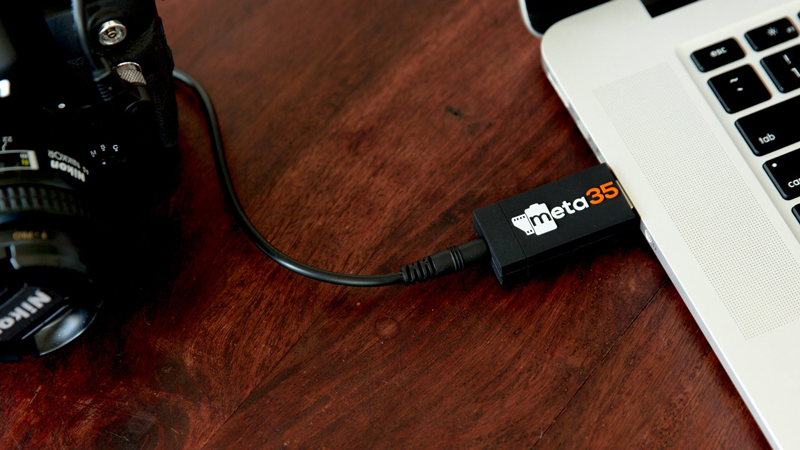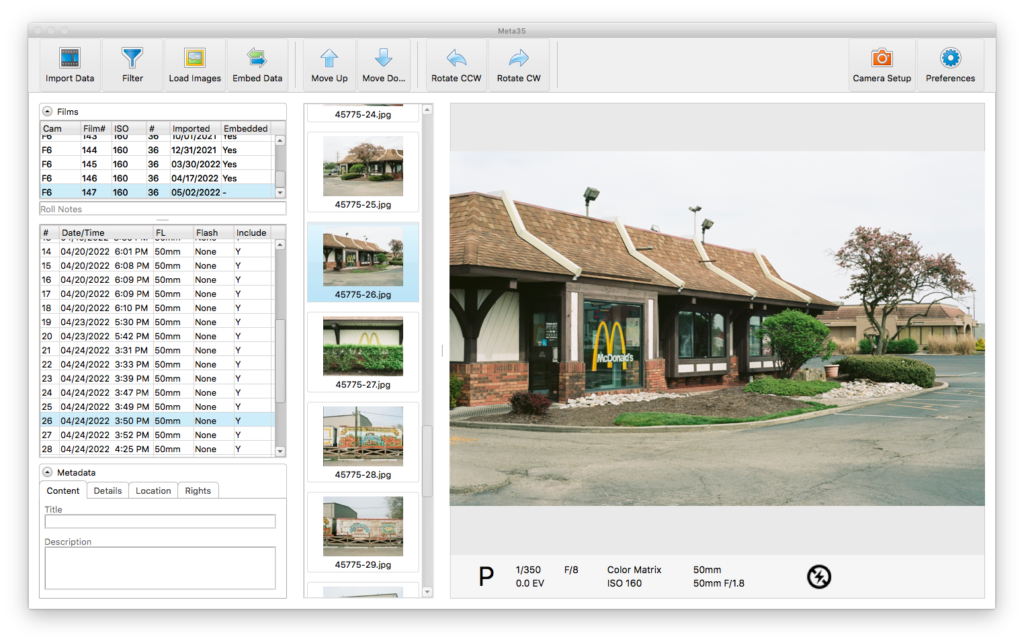With modern digital photography, we take for granted that every JPEG or RAW file our cameras generate will contain useful metadata about the camera settings used to create that image. When I started shooting film, it was hard to get used to the idea that if I wanted to remember the aperture or shutter speed I used, I would need to manually take notes; and if I wanted to add this information to the JPEG, I’d have to use software like Exif Editor to manually add it to one photo at a time. Surely, there was a better way.
While looking for a solution to this problem, I learned that several cameras released towards the end of the film era recorded metadata internally. For example, the Nikon F6 has enough internal memory to store “detailed” metadata about your most recent 31 rolls of film. (You can also change a setting and have it instead store “basic” data for your last 57 rolls.) Then, using an accessory called the MV-1, you can download this information to a CompactFlash card — very state-of-the-art for 2004.
Then I came across the final piece of the puzzle. In 2015, a company called Promote Systems released a hardware and software solution called Meta35 that allows you to connect any of the supported cameras directly to your computer and sync the metadata onto your film scans. I was amazed that a company had already put in the time and effort to solve this extremely niche problem, so I decided to buy a Nikon F6 and a Meta35 and give it a go.

In 2019, I bought a Nikon F6 and began using it as a replacement for my Canon AE-1. (I have really enjoyed using it and plan to write separately about it in the future.)
However, acquiring a Meta35 hardware dongle turned out to be more difficult than expected. The big online camera stores had none for sale. I searched eBay and found them reselling for outrageous prices, on the rare occasion that one was listed for sale.
While waiting to find the hardware device, I also downloaded the Meta35 software, only to find that it hadn’t been updated in several years and would not work with any Apple operating system newer than macOS 10.12, which was released in 2016. Additionally, macOS 10.15 was set to be released in 2019, dropping compatibility with older 32-bit apps. I wrote to Promote Systems to ask if their software would be updated to support newer versions of macOS and got a short response: “We do not plan to update to 64-bit.” At that point, I realized that the Meta35 product had effectively been abandoned.
I briefly considered another option: trying to find a Nikon MV-1, using that to sync the data from my camera onto a CompactFlash card, using a series of adapters to transfer the file onto a modern computer, and maybe writing my own script to sync this onto my film scans. Unfortunately, the MV-1 was also very rare and expensive. So, for awhile, I mostly just forgot about it and continued using my Nikon F6 just like any other “dumb” film camera.
Finally, in 2021, I checked the Meta35 website and found that Promote Systems was shutting down and selling off their remaining supply of Meta35 units. I realized that if I ever wanted to try it out, this may be my last opportunity, so I picked one up.
The next challenge was trying to get the software to work. I tried to run macOS 10.12 in a virtual machine on a modern Mac laptop, but I couldn’t get the Meta35 software running in the VM to see the hardware device. My last ditch effort was to downgrade an older MacBook Air to run macOS 10.12 and use this as a dedicated Meta35 laptop… and it worked!

I was able to connect my Nikon F6 to the MacBook Air and import the metadata. Then, I could load in the film scans that I downloaded from The Darkroom and transfer the metadata onto them. Now, each of the JPEGs contains accurate information about the date and time that the photo was taken and all of the camera settings used. When I view my film scans in Lightroom and on Flickr (see example), I can see what mode the camera was in, what lens I was using, what aperture and shutter speed were used, and lots of other information.
And now each JPEG has the correct date and time (when the photo was taken, not when it was scanned) so the photos appear in the correct order when I add them to my photo libraries, including Google Photos and Photos on iOS and macOS.
I’m not going to nitpick the quirks of 7-year old software that was probably written by a single developer or a very small team for a niche purpose. It’s a little outdated by today’s standards, but it does what it’s meant to do. I had to jump through a few hoops to get it working, but I’m glad I did. (If you have gone through a similar process to get Meta35 working, or have figured out a way to run it on a modern Mac laptop, please leave a comment!)
All of the Nikon F6 photos I’ve uploaded to Flickr since September 2021 contain EXIF data added via the Meta35, in case you want to see the results for yourself.
More about the Meta35:
